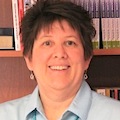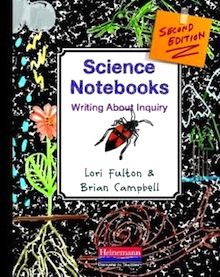Using Science Notebooks to Grow Student Ownership
Science Notebooks: Writing about Inquiry (2nd Edition)
by Lori Fulton and Brian Campbell
(Heinemann, 2014 – Learn more)

Lori Fulton and Brian Campbell have created another practical and thought-provoking book with their Second Edition of Science Notebooks: Writing About Inquiry. If you read the first edition, you’ll find changes in this version that help align their notebook strategy to the Common Core and the Next Generation Science Standards.
If you’re looking for a “how-to” book, there’s plenty of that in this new edition. But what’s really great about this book is how it presents the outline of a teaching idea and then supplies a classroom story that illustrates what the strategy looks in action. Their approach asks a bit more more of the reader, because you have to read closely and think through the illustration, but the payoff can be considerable. These actionable ideas might even help shift your thinking about the way you currently approach science teaching.

Clearly, (b) is the harder path for most of us. But if our quest is to create a classroom that is learner-driven, this is the path we must follow. And Fulton and Campbell are committed to helping us all along the way.
Once they let the reader in on their thinking behind choice (b), they give us even more to ponder in Chapter 3: What’s the most effective way for a teacher to reflect on how the lesson went and then decide what should happen next?
As you progress through the book, this continuous focus on and support for teacher reflection allows the teacher reader to take the content and the instructional philosophy (student ownership) and consider the best ways to implement science notebooks within their own classroom.
More tools for reflection
Throughout each of the chapters, there are features called “Thinking Points” that suggest ways to dialog with others in small book studies, or even by yourself.
One of my favorite reflection questions comes in Chapter 3 where the authors are describing how a teacher might track student progress while encouraging kids to take ownership of their learning through the use of a science notebook.
The Thinking Point pushes the reader to not only collect evidence of learning but to carefully consider how that evidence will be used….and then how the evidence can drive the teacher to “allow students to improve in each of these (target) areas so that their notebooks support learning in science.”
Here is another strength of the book: in these Thinking Points (and elsewhere) the authors never tell you what to think; instead, they offer the wonderings that will guide readers toward making decisions for themselves.
Authentic science

Lori Fulton & Brian Campbell
For teachers who are wondering how all this connects back to real-world work of scientists and engineers, Chapter 4 provides a rich dialogue with science practitioners about “authentic implementation.” Each individual interviewed by Fulton and Campbell brings a unique perspective from the world of observational fieldwork, engineering, forensic science and engineering. Teachers will find pearls of wisdom here as well as ideas on how notebooks could be designed electronically.
Chapter 5 offers a good starting point for how science notebooks connect to the NGSS Practices. My only suggestion for improvement would be to include more discussion about how we can lead students to understand the difference between an explanation and an argument. Both are vital pieces in the NGSS and the differences can be confusing as teachers try to lead science students in learning how to do each of these types of writing.
The back cover speaks to Fulton and Campbell’s intent of “inspiring thousands of teachers” and this book certainly meets their objective. It is a book that will be read again and again…becoming dog-earred with the repeated readings, sure to provide new insights each time.
Marsha Ratzel is a National Board-certified science and math teacher in the Blue Valley (KS) School District and a popular blogger (Reflections of a Techie). In the past three years she has taught 6th and 8th grade science and 8th grade algebra. Ratzel has also written about connected learning and expert teaching practice for Education Week, Voices from the Learning Revolution, Educational Horizons and other publications. Her first book, Teaching in High Gear, chronicles her own journey toward a student-centered, inquiry-driven science classroom.


































